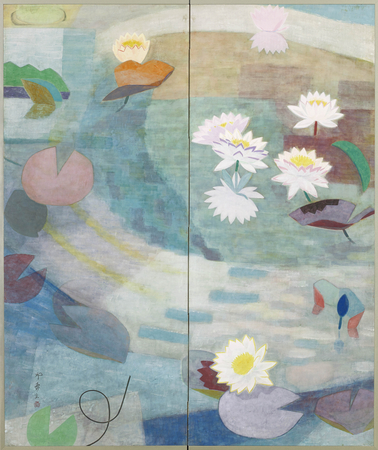Product Description
7118 A two-fold paper screen painted in colour with a lotus pond
Signed: Inshō sei
Seal: Inshō
Japan 20th century Shōwa period
Dimensions: H.70″ x W. 58¾” (177.5cm x 149cm)
Inshō Dōmoto (1891-1975).
Dōmoto was born in Kyoto to a family of affluent sake merchants with the given name Sannosuke. After graduating in 1910 from the Kyoto-shiritsu Bijutsu Kōgei Gakkō (Kyoto City School of Arts and Crafts) he began his career by drawing patterns for traditional textiles called Nishijin-ori.
Between 1918 and 1924 he studied Nihonga at the Kyoto Shiritsu Kaiga Senmon Gakko (Kyoto City School of Painting) and throughout his career he was strongly associated with and generally considered a master painter of the Kyoto Gadan (the Kyoto School of Nihonga). Dōmoto also studied with Suisho Nishiyama (1879-1958), the influential pupil of Seihō Takeuchi (1864-1942).
In 1919 his work titled “Landscape of Fukakusa” was exhibited at the 1st Teiten (Imperial Academy of Fine Art Exhibition) and in the 3rd Teiten his work “Women Playing Football” was awarded a special prize. In 1925 Domotō’s large painting of Buddhist themes “Kegon” won the first Grand Prix awarded by the Teikoku-Bijutsuin (The Imperial Fine Art Academy).
After his success at the Teiten exhibitions Domotō established himself as a specialist in large-scale religious paintings and began to receive commissions from distinguished Buddhist temples in the Kansai area. He painted the walls in the Shitennō-ji, Osaka and in the central pagoda at Kongōbu-ji, Kōyasan (Wakayama Prefecture) and his production of paintings for Buddhist temples should be considered an important element of his oeuvre.
Later Dōmoto established his own painting school known as “Tokyusha” and was also teaching at the Kyoto Municipal Special School of Painting.
In 1944 he became a member of the Imperial Art Academy and in 1950 a member of the Geijutsuin (the Japan Art Academy). After 1955 he pursued abstract expressionism which stimulated Japanese painting circles. Domotō cultivated a strong interest in history, aesthetic theory, and Western art from the Old Masters to Cubism.
In 1961 he received the Order of Cultural Merit and in 1966 Domotō Museum of Fine Arts was established.
Works by the artist can be found in the collections of: Daigo-ji, Kyoto; Dōmoto Art Museum, Kyoto; Kongōbu-ji Kōyasan, Wakayama; Kyoto City Art Museum, Kyoto; Museum of Fine Arts, Boston, Massachusetts; National Museum of Modern Art, Tokyo, Shitennō-ji, Osaka.








